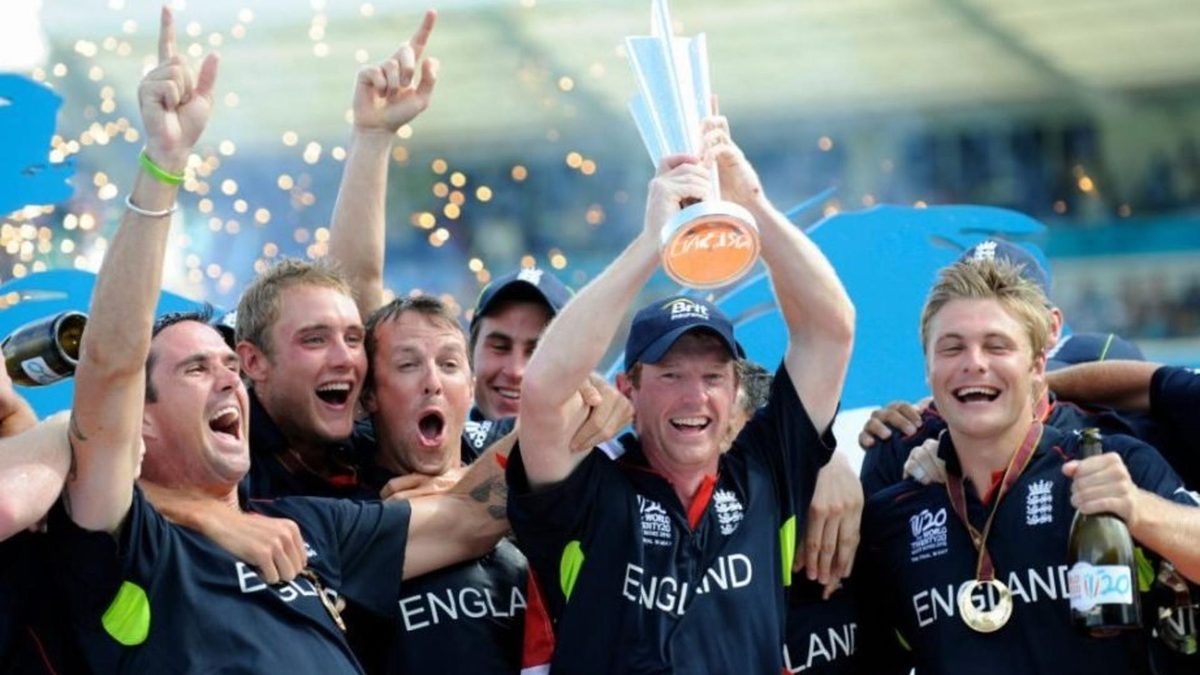
Luke Wright, Michael Yardy and Michael Lumb speak to Taha Hashim
Taha Hashim revisits the story of England’s successful 2010 World T20 campaign, through contributions from members of the winning XI.
Craig Kieswetter, South Africa-born, qualified to play for England on a Tuesday. On the Wednesday he hit 81 from 66 balls against his new team. On the weekend he was named for a tour of Bangladesh, when he would make an ODI hundred. Craig David, eat your heart out.
That Wednesday produced one of English cricket’s lightning-bolt moments. Kieswetter’s assault for England Lions, taking place in a T20 match in Abu Dhabi, was not disruptive but rather a lesson for the seniors. Alongside the 22-year-old at the top of the order was a 30-year-old Michael Lumb,experienced at county level but,like Kieswetter, uncapped.He too would hit an attacking match-winning fifty that day in a chase of 158, returning to the crease to finish unbeaten on 58 after a blow to the chin from Stuart Broad had forced him to temporarily retire hurt.
“It could have been a different story,” Lumb says. “I remember Craig getting dropped early on by Broady [Broad] at mid-off or mid-on, and I wasn’t due to open in that game. Craig was doing quite well and probably the flavour of the month at the time so I didn’t give much thought of England selection.”
Kieswetter and Lumb had shown the opposition what they so desperately lacked less than three months outfrom the start of the 2010 World T20. The openers for the senior side that day were Jonathan Trott – steady but slow – and Joe Denly, in his first incarnation as an England international. Management were soon to realise that a more brazen approach would be required for some enjoyment under the Caribbean sun.
In the T20I series against Pakistan that followed England’s defeat to the Lions, the writing was on the wall. “Andy [Flower, England’s head coach] made me apologise to the team again after a T20 match against Pakistan in Dubai in February 2010,” Trott later wrote in Unguarded, his autobiography. “I had messed up, it’s true, in making 39 from 51 balls when opening the batting.
“It was pretty obvious in Dubai that Andy wanted to find a way to get Craig Kieswetter and Michael Lumb into the side. He asked me to move out of the way in the dressing rooms once as he was trying to watch Lumb play in the Indian Premier League on TV.”
Trott’s premonitions weren’t misguided. It was in Delhi while with Rajasthan Royals that Lumb received the call that he was off to the World T20. Kieswetter was going to join him there.
***
England arrived in the Caribbean displaying the hallmarks of the Flower era. The Test side had regained the Ashes at home the previous summer and were now just months away from a trip Down Under that would bring to an end 24 years of pain. These were the happy days, before the turmoil that was to come.
Taking the lead alongside Flower was captain Paul Collingwood, a calm presence who preached enjoyment to his players, taking away the stresses that come so naturally with a high-profile tournament.
“I had times under Andy where it was more intense, but I think Colly [Collingwood] was keen to keep T20 with an emphasis on fun,” recalls Luke Wright, who had been part of England’s two previous World T20 squads. “He sensed that previously we’d piled on pressure, whereas he wanted us to go out and enjoy it, and that was what it felt like. Of all the times I played for England that was the most enjoyment I had on and off the pitch as part of a group.”
Newcomer Lumb could sense it too. “I always thought it was quite a special group of players. I was new on the scene, but I thought it was a fantastic group of lads who got on. There was a great sense of camaraderie amongst the group.”
[caption id=”attachment_146790″ align=”alignnone” width=”800″]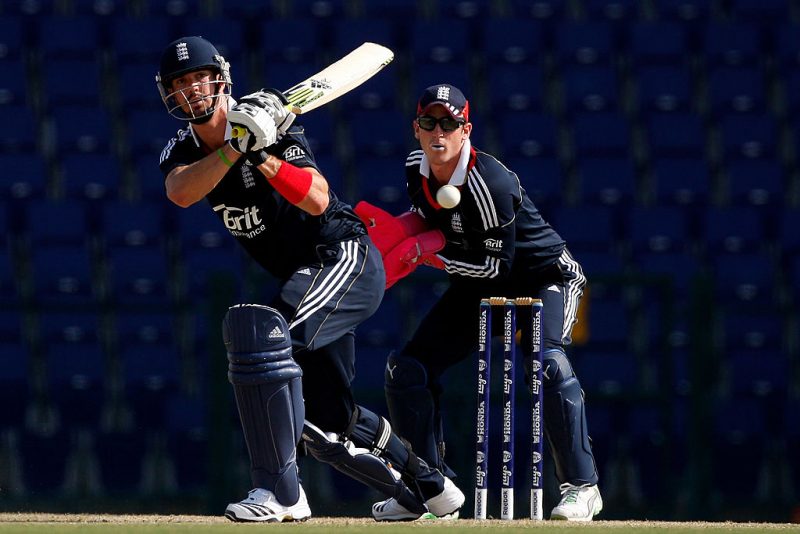 Craig Kieswetter takes on keeping duties in the Lions v England match[/caption]
Craig Kieswetter takes on keeping duties in the Lions v England match[/caption]
The positivity was harnessed through the clarity of roles for each member of the XI, with clear instructions laying down what was required for success in the shortest format.
“This was one of the big reasons why we were successful,” says Michael Yardy, the all-rounder making his international return after three years on the outer. “The one thing noticeable was that they knew how they wanted the team to be set up and picked the players they felt could fulfil those roles, rather than pick the best six batsmen when four might’ve been openers who you were trying to fit in.”
At the top, Kieswetter and Lumb were to go from ball one. “That was our role, to get the team off to a flier,” explains Lumb. Then came the established stars for whom the platform would be set: Kevin Pietersen, skipper Collingwood and Eoin Morgan. Wright was sealed in as the late-innings hitter. Batting practice involved range-hitting competitions, testing out who could hit the ball the furthest. “If you want to go and attack someone and you feel the odds are in your favour to take them down, then you’ve got to go and do that,” Yardy recalls of England’s batting plans in the tournament. “It wasn’t very complicated, but it was right.”
Ryan Sidebottom and Tim Bresnan were to open things up with the new ball, with Broad the third seamer. Spinners Yardy and Graeme Swann would take the middle overs, choking the opposition before the seamers finished off with variations which had yet to become commonplace in the shortest form. “The seamers were good at using a lot of slower-ball bouncers which weren’t used a lot 10 years ago,” Yardy says. “Everyone had clarity in what their roles were and very rarely did people go away from their roles.”
The backing afforded to members of the first-choice XI worked a treat. Only one change was made over the course of the tournament, with Ravi Bopara filling in for Pietersen in a Super Eights match against New Zealand after the latter flew home for the birth of his son.
“They [Collingwood and Flower] gave me the backing and said I was going to play all the games and that I should just play the way I play at Hampshire, just go out and enjoy it and have fun, which put me at ease,” says Lumb. “I thought that was great man-management.”
“We pretty much fielded the same places for every bowler throughout the tournament,” says Wright. “We just got into a rhythm and routine every game, and it seemed to work.”
***
Not everything went to plan to begin with, however. After comfortable warm-up wins over Bangladesh and South Africa, rain was the killjoy in England’s first group-stage match against West Indies in Guyana. Despite putting up an imposing total of 191-5, adverse weather saw Duckworth-Lewis hand the hosts a revised target of 60 from six overs, 30 runs and 2.2 overs into their chase. It was music to the ears of Chris Gayle and co. as they took victory with a ball to spare.
Against Ireland, rain was more beneficial. After England scraped to 120-8, thanks largely to Morgan’s 37-ball 45, Ireland were 14-1 after 3.3 overs when the match was abandoned. England’s superior net run rate took them through to the Super Eights despite their winless record.
Confidence hadn’t dipped, though. “There wasn’t a negativity that we hadn’t got the result in the two games, just the relief that we’d shown that we could do something really special in the tournament,” explains Yardy.
[caption id=”attachment_146791″ align=”alignnone” width=”798″]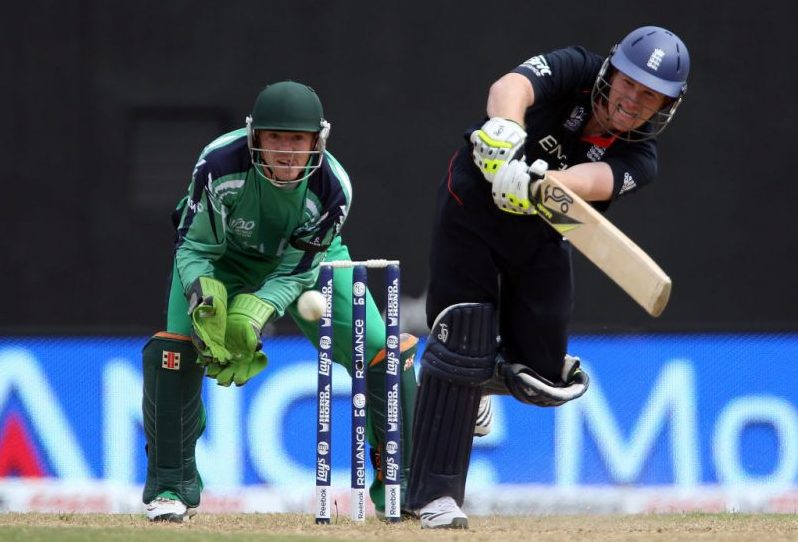 Eoin Morgan on his way to 45 against Ireland during the group stage of the 2010 World T20[/caption]
Eoin Morgan on his way to 45 against Ireland during the group stage of the 2010 World T20[/caption]
“We all felt that if we hadn’t gone through, we wouldn’t have done ourselves justice, and it would’ve been harsh on us,” says Wright. “If it had been a full game we would have beaten West Indies. We got that bit of luck to get us through against Ireland and that was it. From that moment it was almost as if more belief came and we went on a roll. Thank goodness for the rain against Ireland.”
They were right to back themselves, with everything finally coming into place in Barbados. A solid all-round bowling performance limited Pakistan to 147-9 before Pietersen blitzed his way to an unbeaten 73 from 52 balls, giving England their first win.Two days later, he was at it again against South Africa, hitting 53 from 33 ballsbefore the bowlers routed the Proteas for 129 to deliver a 39-run win. Pietersen would go on to be named Player of the Tournament.
“KP was on absolute fire,” Wright says. “I’ve never seen him play any better. He was playing on a different level to anyone else.”
Lumb concurs. “Kev was just streets ahead of everyone else. I just thought he was so much better than anyone else we played against, and the way he went out and just dominated attacks – he was probably the rock and platform of our batting group. When he was at the crease, the confidence that we all had when he was out there, and the way we played – without him it’s fair to say we wouldn’t have gone as far as we did. He was world-class and still one of the best players I’ve ever seen.”
Despite the temporary loss of Pietersen’s services, the pressure was off against New Zealand after England’s semi-final berth was sealed following Pakistan’s victory over South Africa. Yet the winning run couldn’t be stopped.
A semi-final against Sri Lanka, World T20 runners-up the previous year, looked a tricky challenge, but once again, a bowling attack that stuck to its plans limited the likes of Kumar Sangakkara, Mahela Jayawardene and Tillakaratne Dilshan to a total of 128-6. Despite Bresnan going at over 10 an over, the four other staples of the line-up encountered few issues.
“Looking back at the figures, most people had a bad day in the tournament,” says Yardy. “I don’t know what the highest score against us was but it wasn’t too many. If someone went for a few, someone else covered it up.”
It was smooth sailing in the run-chase, with Pietersen’s unbeaten 42 helping England across the line with four overs to spare.They were through to their first World T20 final.
“I remember speaking to Yards [Yardy] and saying, ‘We’ve got a real chance here. Everyone’s happy, everyone’s contributing’,” says Wright. “That was a big moment for all of us, beating such a good side with some of the best names that have played the game.”
[caption id=”attachment_146792″ align=”alignnone” width=”800″]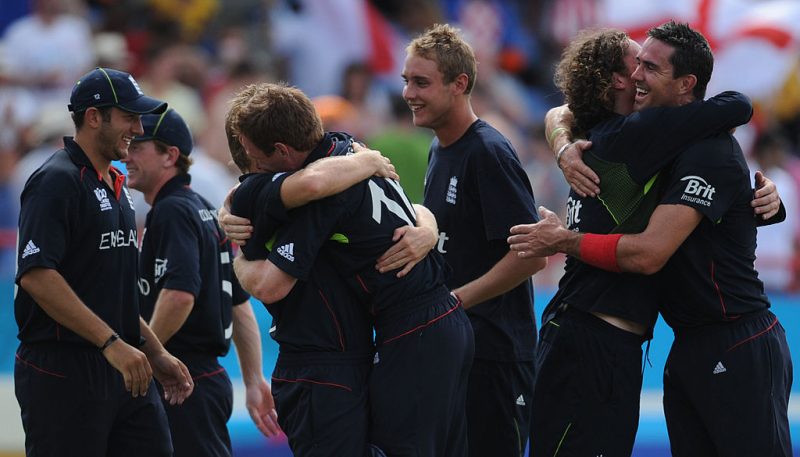 England celebrate victory over Sri Lanka in the semi-final of the 2010 World T20[/caption]
England celebrate victory over Sri Lanka in the semi-final of the 2010 World T20[/caption]
Having a good time off the pitch was another prominent factor in England’s success. “I remember a lot of it was training hard in the morning, then beach and golf in Barbados in the afternoons,” says Wright. “We’d celebrate a win and that’s what we played for,” adds Lumb. “We all knew when to turn it on, and where to take it off.”
It’s little surprise to know where Wright was when Michael Hussey pulled off his heist against Pakistan, setting up a final between the two old sluggers.
“I was playing golf with Broady and a few of the guys. You looked down the list of that Australian team and they looked like an absolute juggernaut of a team.
“When we thought Pakistan would be coming through, before Hussey came off, I think we were pretty relieved. But once you’re in a final anything can happen; you actually realise it’s a dream final. England-Australia, you can’t ask for more than that, and if you win it’s even more special with it being Australia rather than Pakistan. Thank goodness they did come through because, looking back, it does make it that bit more special.”
***
Bridgetown, where England had beaten Pakistan and South Africa in the Super Eights, was the picturesque setting for England’s first ICC tournament final in six years. Unlike another final nine years later, there was little drama; England’s victory march began early, with Sidebottom dismissing Shane Watson in the opening over of the match. Halfway through their innings, Australia were languishing at 47-4.
Twenty-one runs from Yardy’s third over – courtesy of some hefty blows from Cameron White and David Hussey – proved to be the only major blip, but once again England’s planning reduced the threat level. Wright was handed the ball for the first time in the tournament.
“I actually felt relaxed about it. I knew that I was coming on to bowl yorkers which had always been my strength. I remember Cameron White spraying me, telling me that I was rubbish, that I wasn’t good enough. I spoke to Dave Hussey about it recently, and he said he couldn’t get round why White was having a go at me. And then I ended up getting him out which was even better! To be fair to Whitey, we’ve played together for the [Melbourne] Stars and laughed about that moment. He just said that he felt he’d won the first battle getting Yards off and knew that we’d not bowled anyone else. He just wanted to make me as nervous as possible and fancied smacking me, and to be fair I’d have fancied facing myself.”
[caption id=”attachment_146793″ align=”alignnone” width=”800″]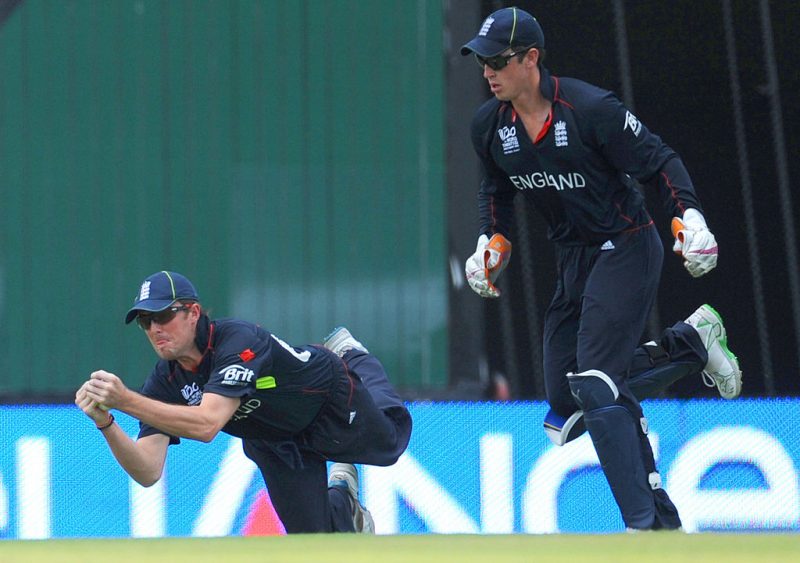 Graeme Swann takes a diving catch to remove Shane Watson in the final of the 2010 World T20[/caption]
Graeme Swann takes a diving catch to remove Shane Watson in the final of the 2010 World T20[/caption]
Along with White’s wicket, Wright conceded just five runs from his sole over. Australia managed a respectable 147-6, but England had given little away. Sidebottom led the way with 2-26, while Swann conceded just 17 runs from his four overs, removing Michael Clarke in the process. With 10 scalps apiece, the two bowlers finished as England’s joint-leading wicket-takers in the tournament.
Inching to the target was not in the script. Kieswetter had enjoyed some middling scores in the tournament, but here he revisited his Abu Dhabi exploits, knocking out 63 from just 49 balls. Alongside him for most of the way was Pietersen, a man rejuvenated by joy in his personal life.
“The hype was all about them,” he wrote in his autobiography. “Australia, Australia. We’d never won a World T20 final, but I knew that I was batting as well as I’d batted in my life. I had a son. And I was walking out to bat feeling on top of the world.
“I remember having throw-downs in the nets before the T20 final in Barbados, and I really was just hitting every ball wherever I wanted to. So I went out there, and we needed 140, 150. Craig Kieswetter was whacking it at the other end and every ball I decided to hit, I hit.”
Even as England closed in, needing just 27 from 35 balls after the dismissal of Kieswetter, comically leaving a straight ball as he advanced down the track, there were nerves for those on the sidelines.
“I just remember I was in next and a nervous wreck,” Wright says. “Yards was laughing and joking, and Flower turned round to him and said, ‘If Morgs [Morgan] is out, you’re going in now – we’ll go leftie for leftie’. I just remember seeing Yards going pale white suddenly, changing from this relaxed state expecting to win the World Cup to realising that we might both have to go out.”
Collingwood eased both of their worries with a winning hit through mid-wicket to cue a pitch invasion and an unforgettable night out in Harbour Lights, although there was still some time for rest after an early finish.
“I remember falling asleep for a bit when I got back to the hotel, just having a kip and waking up to 20 missed calls with the boys out and about, so I had to go and find them,” Lumb recalls.
[caption id=”attachment_146794″ align=”alignnone” width=”800″]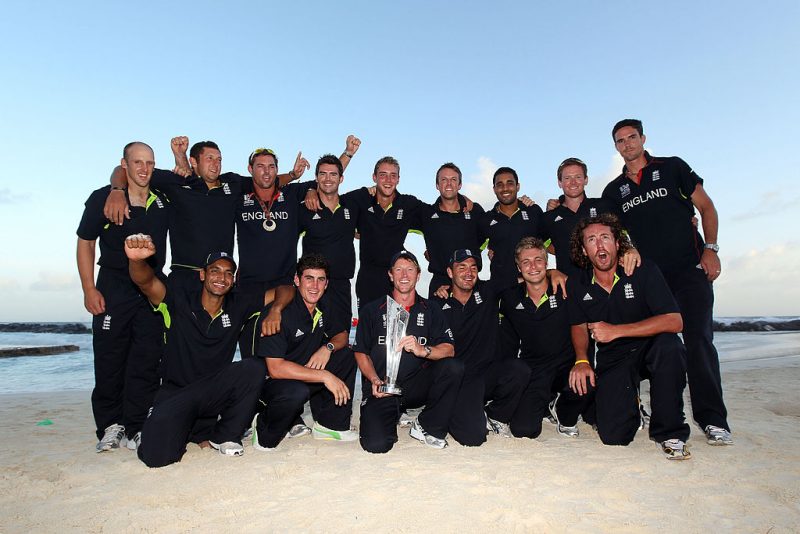 England celebrate after winning the 2010 World T20[/caption]
England celebrate after winning the 2010 World T20[/caption]
“Six weeks before I was just excited about being in the squad, next thing you’ve been part of the team that’s won the T20 World Cup,” says Yardy.
“I think a lot of the time, it feels like it’s the forgotten World Cup,” Wright says. “So much has been spoken about the 50-over World Cup that we won, and rightly so. But being the first-ever World Cup and ICC tournament that England won, when we achieved it, it made it feel so special.”
The good times didn’t roll on for England’s limited-overs sides.Barring a run to the 2013 Champions Trophy final, other tournaments over the following five years only delivered disappointment. By the end of the 2015 50-over World Cup, after a group-stage exit that would precipitate a revolutionary shift in style, England’s white-ball efforts looked antiquated in comparison to the rest of the world.
“Maybe after that they went back to ‘old England’ a bit,” Lumb argues. “There were similar sides in Test cricket and white-ball cricket, and I think they probably took their foot off the gas a little. With the T20 World Cup, Andy and Paul had a set plan of how they wanted to go about things. And I think the period after that, there wasn’t much planning in how they wanted to play.
[breakout id=”0″][/breakout]
“It’s only since Morgs [Morgan] and Trevor [Bayliss] came along with how they wanted to go about things that it changed. But I think it all just went a bit old school. The game kept on moving and maybe England just stood still in the way they were thinking and the plans they had in that period.”
Nevertheless, for three weeks in the Caribbean, England were the side that had it all together. “It came a little out of the blue,” says Yardy. “But if you get a team that gels together, plans are clear and people fulfil their roles, then anything can happen.”








